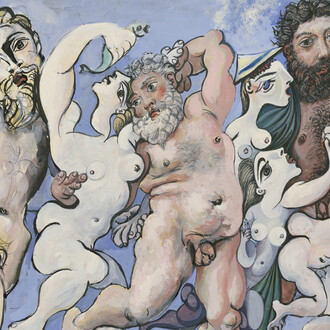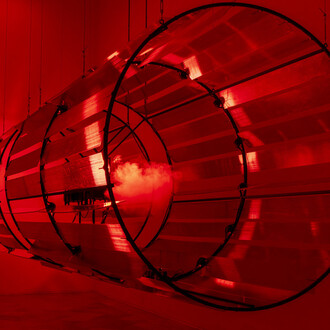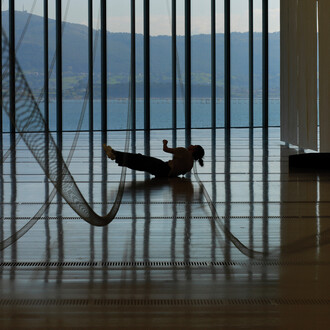Piet Mondrian’s paintings, especially those created after 1919, begin to experience what he described as “a real and completely human harmony.” In a way, this synthesis can also be observed in the new paintings presented by Ulrich Wulff in his first solo exhibition in Spain. His works delve deeply into the concrete and self-sufficient world of painting itself.
Following in the footsteps of Lucio Fontana, Robert Ryman, Blinky Palermo, and Günther Förg, Wulff turns the entire pictorial surface into the image of the painting itself. He does not paint an image within a painting, but rather uses the entire surface as the image. In a direction that might be called Cézannean, he gives equal pictorial weight to every area of the painting’s surface.
For Ulrich Wulff, formal experimentation is replaced—or more accurately, absorbed—by the human as the unit of measurement. Everything in his work is connected to the human. The meaning of painting responds to the totality of a body as the vital foundation of the artwork. The subject of his painting is not geometry, nor does it operate through geometric logic. This would imply surrendering the power of definition and conception of painting to a single evaluative framework or purpose. Instead, Wulff’s new works, as a whole, turn their focus toward internal rather than external measurement.
In the painter’s own words, they follow the Bildmaß or theory of measure (also translated as “push forward measure” or “image measure”), which posits an equivalence with the truth of painting—its self-awareness. This Bildmaß explores the relationships within painting that are not limited to the pictorial plane, nor deduced from reality. In his paintings, everything is the same: there is no distinction between pictorial lines and clearly outlined fields of color. Even though line and color appear different to our eyes, their inner being forms a total unity. The line expands and acts as a field of color, while the flat color is realized through the contrasting tones that surround and define it.
Everything is visible and pure. Pictorial invention and human experience unite. Wulff’s paintings are neither symbols nor geometries, yet they still question certain dynamics of time or systems of proportion and scale. Rather, they are presence or vibration, sustained by something akin to what John Cage, in his particular search for an “earthquake-proof music,” called “flexible time brackets.”
What is fascinating is that Wulff does not think in terms of themes or series or in terms of individual motifs. The theoretical concern is directly tied to the intuitive development of the surface. His painting is much more connected to a new sensibility capable of expressing itself autonomously regarding certain pictorial truths than with the formalization of specific geometries. These are flat surfaces connected to the human. While in historical avant-gardes the flat form was equated with exalted spirituality or the general essence of things, here the plane, the surface, contains a vital experience conditioned by the pictorial field.
It is astonishing and unusual that the main value of these paintings—matter—paradoxically dissolves into presence or radiance. Wulff consciously asserts that the only way for painting to be perceived is through its material dimension, and that the only possible path toward its potential spirituality lies in the physical quality of the world’s materiality. The material as the sole connection to the spiritual.
This painting seems to dissolve and disappear, weightless, on a surface where color and line are unified. From its flatness, the vertical or tilted forms, the vibration of the colors (some corporeal and fleshy, others metallic and faded), and the dissolution of contours—which transform color into line and line into tone (approaching and receding, almost magnetically, building and dissolving form)—neutralize and eliminate the distinction between figure and ground, between matter and non-matter. The corporeality of matter seems to disintegrate on the plane of Wulff’s paintings, thus becoming transparent and crystalline.
Visually, there is an image, but it disappears and is eliminated in favor of the subtle, clean, layered plane that reaffirms the two-dimensionality of the pictorial surface. The gleam of golds and silvers is moving, hypnotic, while the pinks and purples, indecipherable, appear as if by magic, offering an initiatory chromatic experience.
Ulrich Wulff’s works captivate and command the eye through a bold, synthetic appearance, and a rhythm and pulse of vibrant dynamism. We might ask ourselves: What moves them? What illuminates them? … John Golding once said of some paintings by Mondrian or Kandinsky that “when we look at them, we feel that something is about to happen,” and “that twilight was the hour of revelation and exaltation.”











![Saul Steinberg, The museum [El museo] (detalle), 1972. Cortesía del Museo de Arte Abstracto Español](http://media.meer.com/attachments/dfbad16c22c5940b5ce7463468ac8879f3b4bf23/store/fill/330/330/042ecf3bcd2c9b4db7ddbc57cb32e950c095835f7b5cd55b6e1576a6e78c/Saul-Steinberg-The-museum-El-museo-detalle-1972-Cortesia-del-Museo-de-Arte-Abstracto-Espanol.jpg)


